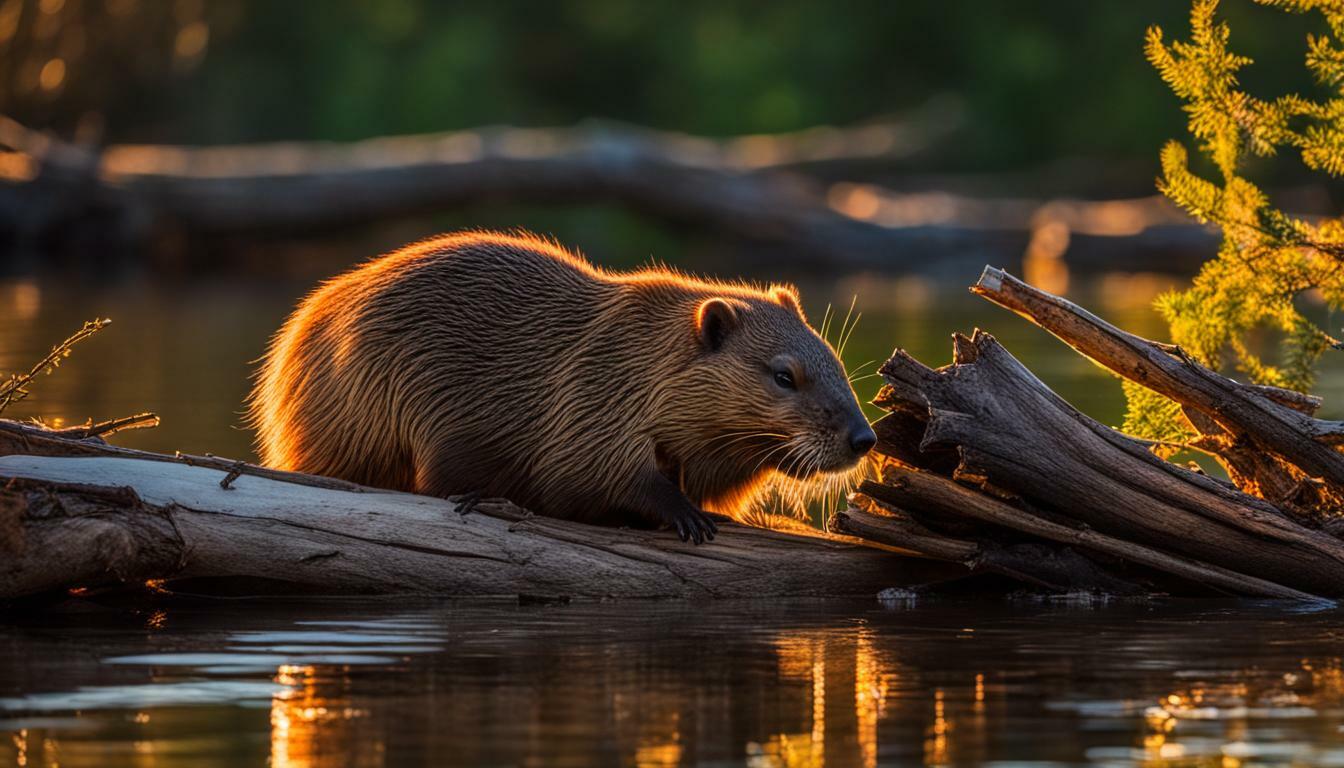Beavers are fascinating creatures known for their ability to build dams and modify their environments, but have you ever wondered if they get splinters? In this article, we will explore the question of whether beavers get splinters and provide an overview of their unique adaptations.
Key Takeaways:
- Beavers do experience splinters occasionally, especially young beavers while chiseling wood.
- However, they quickly learn to be more careful and choose softer bark and tender wood to avoid injuring themselves.
- The beaver’s teeth constantly grow, and they file them down by chewing on twigs, which helps prevent splinters.
- The beaver’s unique tooth structure, including iron-hardened enamel, allows them to gnaw underwater without getting water and splinters in their mouths.
- Beavers play an important role in creating habitats and regulating ecosystems through their ability to build dams.
The Anatomy of a Beaver
To understand whether beavers get splinters, it’s important to explore their unique anatomy and how it helps them navigate their woody habitats. These fascinating creatures have several adaptations that contribute to their ability to avoid splinters.
Beavers have incredibly strong and sharp incisors that grow continuously throughout their lives. These teeth are perfect for gnawing on wood, but you might wonder, don’t they get splinters? Surprisingly, beavers rarely experience splinters thanks to their tooth structure. The enamel on their incisors is composed of iron, making it incredibly hard and resistant to splintering. This iron-hardened enamel allows beavers to chew on wood without fear of getting splinters in their mouths.
Not only do their teeth prevent splinters, but beavers also know how to choose the right kind of wood to minimize the risk. Young beavers may occasionally get a splinter in their gums or lips while they are still learning, but they quickly learn from their experiences. These lessons teach them to select softer bark and tender wood, which is less likely to cause injuries.
The Teeth of a Beaver
| Key Characteristics | Benefits |
|---|---|
| Constantly growing incisors | Allows beavers to continuously maintain their teeth at an optimal length, preventing splinters |
| Iron-hardened enamel | Resists splintering while gnawing on wood |
| Ability to file teeth by chewing on twigs | Keeps their teeth sharp and healthy |
Overall, the anatomy of a beaver plays a significant role in preventing splinters. Their constantly growing and iron-hardened teeth, along with their ability to choose the right kind of wood, ensure that beavers can navigate their woody habitats without the worry of splinters. These unique adaptations are just some of the many fascinating traits that make beavers such remarkable creatures.
Beavers and Chiseling Wood
Beavers are skilled at cutting down trees and shaping them for their dams and lodges, but this activity also exposes them to the risk of splinters. Like humans, beavers can experience the discomfort of splinters, particularly when they are young and still learning the art of wood-chiseling. It’s not uncommon for a young beaver to get a splinter in their gums or lips during the process. However, these curious creatures quickly learn from their experiences and adapt their behavior to minimize the risk.
Interestingly, the splinter serves as a valuable lesson for young beavers. They become aware of the need to choose softer bark and tender wood to avoid injuring themselves. In essence, the splinter acts as a natural teacher, guiding them towards safer wood selection. It’s a fascinating example of how animals learn from their mistakes and evolve to protect themselves.
One of the reasons beavers can handle wood-chiseling without constant splinter problems is their unique tooth structure. Beavers have incredibly strong and constantly growing teeth, which they file down by chewing on twigs. This constant dental maintenance helps prevent splinters by ensuring their teeth are in excellent condition. Their teeth are also protected by iron-hardened enamel, further reducing the chances of splinter-related discomfort.
| Beaver Chiseling Tips | Benefits |
|---|---|
| Choose softer bark and tender wood | Minimized risk of splinters |
| Constantly file teeth by chewing on twigs | Prevents splinters and maintains dental health |
| Iron-hardened enamel | Added protection against splinters |
Another remarkable feat of beavers is their ability to gnaw underwater without getting water and splinters in their mouths. This is made possible by their specialized tooth structure and the position of their lips, which create a watertight seal as they work. These adaptations allow beavers to carry out their wood-chiseling activities efficiently, even in aquatic environments.
Splinters in beavers
While beavers do experience the occasional splinter, they have evolved unique adaptations to minimize the risk and discomfort. From choosing softer wood to constant dental maintenance, these remarkable creatures have found ways to thrive in their wood-chiseling endeavors while avoiding the nuisance of splinters.
Learning from Experience
When a young beaver gets a splinter, it serves as a valuable lesson that helps them choose softer bark and tender wood to avoid future injuries. Beavers, like humans, can occasionally experience splinters while chiseling wood. However, they quickly learn from these experiences and adapt their wood-chiseling habits accordingly.
One of the fascinating traits of beavers is their constantly growing teeth. Their teeth never stop growing, and they file them down by chewing on twigs. This behavior not only helps them maintain the length of their teeth but also prevents splinters. The beaver’s unique tooth structure, including iron-hardened enamel, allows them to gnaw underwater without getting water or splinters in their mouths.
By learning what type of wood to avoid and how to navigate their surroundings, beavers are able to minimize the risk of splinters. Their strong teeth and ability to build dams also contribute to their important role in creating habitats and regulating ecosystems. Beavers’ actions have a significant ecological impact, resulting in altered landscapes and increased biodiversity.
| Impacts of Beaver Activities | Description |
|---|---|
| Altered Landscapes | Beavers’ dam-building activities can transform river systems and create wetland habitats. |
| Biodiversity | Beaver ponds create diverse ecosystems that support a variety of plant and animal species. |
| Water Regulation | Beaver dams help regulate water levels, preventing flooding and drought. |
- Beavers learn from experience and adapt their wood-chiseling habits to avoid splinters.
- Their constantly growing teeth and unique tooth structure help prevent splinters.
- Beavers’ actions, such as dam-building, contribute to their important role in creating habitats and regulating ecosystems.
Overall, while beavers may occasionally get splinters, they have evolved fascinating adaptations to minimize this risk. Their ability to learn from experience, constantly grow their teeth, and gnaw underwater without getting water and splinters in their mouths showcases their unique abilities. These adaptations, combined with their ecological impact, make beavers truly remarkable creatures in the natural world.
Constantly Growing Teeth
Beavers have constantly growing teeth, which they keep in check by chewing on twigs, preventing the formation of splinters. These unique teeth are one of the fascinating adaptations that help beavers in their wood-chiseling activities.
When a beaver gnaws on a branch or tree trunk, its teeth are subjected to considerable stress. However, their teeth are specifically designed to handle this pressure. The enamel on a beaver’s incisors is exceptionally hard, making it durable and resistant to splintering. This iron-hardened enamel not only allows beavers to chip away at wood safely but also enables them to chew underwater without any discomfort.
The constant growth of their teeth plays a crucial role in preventing splinter-related injuries. As beavers chew on twigs and other woody materials, the gnawing action helps wear down their teeth, keeping them at a manageable length. This self-maintenance mechanism ensures that the beavers’ teeth remain strong, sharp, and free from splinters that could potentially cause harm.
| Key Points | Benefits |
|---|---|
| Constantly growing teeth | Prevents the formation of splinters |
| Iron-hardened enamel | Allows gnawing underwater without discomfort |
| Chewing on twigs | Keeps teeth at a manageable length |
Beavers’ constantly growing teeth, combined with their ability to file them down, not only guards against splinter-related injuries but also enables them to carry out their vital role in shaping ecosystems. Through their wood-chiseling activities, beavers build dams and create habitats that benefit a wide variety of other species. Their unique adaptations and behaviors make them fascinating creatures, contributing to the awe-inspiring natural world we live in.
Gnawing Underwater
The iron-hardened enamel on a beaver’s teeth and their ability to close their lips behind their teeth allow them to gnaw underwater without the risk of splinters. This unique adaptation enables beavers to gather food and build dams with ease, even in aquatic environments.
Beavers have constantly growing teeth that require regular maintenance. They achieve this by gnawing on twigs and branches, which naturally files down their teeth and prevents the formation of splinters. The beaver’s teeth are incredibly strong, allowing them to chew through tough wood without the worry of injuring themselves.
While gnawing underwater, the beaver’s closed lips create a seal, preventing water from entering their mouths. This, combined with their iron-hardened enamel, ensures that they can chomp through wood without encountering any unwanted splinters. The ability to gnaw underwater gives beavers a significant advantage when it comes to building dams and constructing their intricate habitats.
| Beaver Tooth Adaptations | Advantages |
|---|---|
| Iron-hardened enamel | Prevents splinters while gnawing |
| Constantly growing teeth | Allows for regular maintenance |
| Ability to close lips behind teeth | Enables gnawing underwater without water and splinters |
In conclusion, beavers possess amazing adaptations that allow them to gnaw underwater without the risk of splinters. Their iron-hardened enamel and ability to close their lips behind their teeth provide the necessary protection to carry out their wood-chiseling activities effectively. These unique tooth structures, combined with the beavers’ remarkable ability to build dams, contribute to their ecological impact by creating habitats and regulating water levels in their surrounding environments.
The Importance of Beavers
Beavers play a crucial role in creating habitats and regulating ecosystems, thanks to their impressive abilities and adaptations. These fascinating creatures have unique traits that make them invaluable in maintaining ecological balance.
One of the key ways beavers contribute to the environment is by building dams. These structures not only create wetland habitats, but also regulate water levels in surrounding areas. By constructing dams, beavers help prevent flooding and ensure a steady water supply for themselves and other species. In fact, their dams can transform landscapes, turning small streams into expansive ponds that support a diverse array of plants and animals.
Beavers’ impact on the environment goes beyond dam-building. Their constant need to gnaw on wood provides additional benefits. By chewing on tree trunks and branches, beavers help maintain healthy forests. Their teeth, which never stop growing, are incredibly strong and resilient, allowing them to file down any potential splinters. This ability to chisel wood without harming themselves ensures that beavers can continue their important work without the risk of injury or infection.
| Ecological Impact | Fascinating Traits | Unique Adaptations |
|---|---|---|
| Creation of wetland habitats | Constantly growing teeth | Iron-hardened enamel |
| Regulation of water levels | Gnawing ability | Ability to gnaw underwater |
| Increased biodiversity |
Beavers are an essential part of the natural world, contributing to the health and resilience of ecosystems. Their ecological impact, fascinating traits, and unique adaptations make them a species worth celebrating and protecting.
Building Dams and Creating Habitats
Through their dam-building activities, beavers reshape landscapes, creating habitats that benefit various species and ecosystems. These industrious mammals construct dams using an intricate system of felled trees, branches, and mud, which results in the formation of ponds or wetlands. These structures not only provide beavers with shelter and protection from predators but also have a profound ecological impact.
Beavers’ dams serve as valuable water storage systems, holding back excess water during heavy rainfall and gradually releasing it during drier periods. This regulation of water levels helps prevent flooding and ensures a consistent water supply for surrounding vegetation. In turn, this promotes plant growth and provides habitats for a wide array of wildlife.
Additionally, the creation of ponds and wetlands by beavers enhances biodiversity by attracting various species that thrive in these unique environments. Birds, amphibians, and insects, among others, are drawn to the abundant food sources and shelter provided by the wetland ecosystem. The presence of beavers also contributes to the development of complex microhabitats, enhancing the overall richness and diversity of the landscape.
| Beneficial Effects | Ecological Impact |
|---|---|
| Regulates water levels | Prevents flooding |
| Creates habitats | Enhances biodiversity |
| Supports plant growth | Promotes ecosystem stability |
The ecological impact of beavers extends beyond their dam-building abilities. These industrious creatures play a vital role in shaping their environments, triggering a chain reaction of benefits for other species. By understanding the positive influence beavers have on ecosystems, we can appreciate their fascinating traits and unique adaptations that contribute to their harmony with nature.
Regulating Water Levels
Beavers’ dam-building activities help control water flow, preventing excessive flooding and maintaining a more balanced water system. These industrious creatures construct dams across streams and rivers by felling trees and piling them up strategically. The resulting structures create ponds or wetlands, which serve as habitats for a variety of aquatic plants and animals. Moreover, the dams slow down the flow of water, allowing it to spread out and seep into the surrounding land, recharging groundwater and contributing to the overall hydrological cycle.
By regulating water levels, beaver dams have a significant ecological impact. They help to prevent downstream flooding by storing excess water during heavy rainfall or snowmelt. This function is crucial in preventing the destruction of habitats and reducing the risk of damage to human infrastructure. Additionally, the ponds created by beaver dams act as natural filters, trapping sediment and pollutants, resulting in cleaner water downstream.
The Role of Wetland Habitats
Wetlands created by beaver dams provide a diverse range of benefits. These habitats offer valuable breeding grounds for amphibians, waterfowl, and fish, enhancing biodiversity in the ecosystem. The wetland vegetation filters nutrients, helps to stabilize soil, and provides food and shelter for a variety of species. Furthermore, beaver ponds contribute to the replenishment of groundwater, which can have a positive impact on surrounding vegetation, including forests and meadows.
| Ecological Impact | Benefits |
|---|---|
| Regulating water levels | Preventing flooding, maintaining a balanced water system |
| Creating wetland habitats | Enhancing biodiversity, stabilizing soil, filtering water |
| Replenishing groundwater | Supporting vegetation and wildlife |
The actions of beavers, with their remarkable ability to build dams, have a profound impact on ecosystems. Through their dam-building activities, beavers contribute to the overall health and sustainability of wetlands, rivers, and surrounding landscapes. As keystone species, they play a crucial role in shaping the environment and promoting a harmonious relationship between humans and nature.
Altered Landscapes and Biodiversity
By creating wetlands and ponds, beavers transform landscapes and provide new ecological niches that support a wide range of plant and animal species. These industrious creatures, with their ability to construct dams and create habitats, have a profound ecological impact.
When beavers build dams, they create a series of interconnected water bodies. These wetlands serve as crucial habitats for numerous species, including amphibians, fish, and waterfowl. The still waters behind the dams provide a breeding ground for aquatic organisms, while the surrounding vegetation flourishes due to the increased water availability. As a result, a diverse array of plant species, such as water lilies and cattails, thrive in these areas.
Furthermore, the altered landscapes created by beavers often lead to increased biodiversity. As the water levels rise, the surrounding floodplain becomes saturated and conducive to the growth of various plant species, including grasses and sedges. This, in turn, attracts herbivores like deer and elk, which graze on the abundant vegetation. Predators such as birds of prey and foxes are also attracted to the area, as they find ample prey species in the newly created habitat.
| Ecological Impact | Beavers |
|---|---|
| Alteration of landscapes | Yes |
| Creation of wetlands and ponds | Yes |
| Increase in biodiversity | Yes |
| Support for plant and animal species | Yes |
Beavers play a vital role in shaping ecosystems and promoting biological diversity. Their engineering activities create habitats for a wide range of organisms, ensuring the health and balance of ecosystems. As we appreciate the incredible adaptations of these fascinating creatures, we also recognize the importance of preserving their habitats for the benefit of countless other species that depend on them.
Harmony with Nature
Beavers’ ability to transform their environment and coexist with other species showcases the remarkable harmony they achieve in natural ecosystems. These industrious rodents have a significant ecological impact, shaping landscapes and creating habitats that benefit a wide range of other plants and animals.
One of the beaver’s unique adaptations is its powerful teeth, which constantly grow throughout their lives. These strong, chisel-like incisors enable beavers to fell trees and build dams, altering the flow of rivers and creating ponds. By constructing these structures, beavers create a variety of habitats that attract numerous species, including birds, fish, and amphibians.
| Ecological Impact | Unique Adaptations |
|---|---|
| Beaver dams help regulate water levels, preventing flooding and droughts that can have devastating effects on surrounding ecosystems. | Beavers’ iron-hardened enamel on their teeth allows them to gnaw underwater without getting water and splinters in their mouths. |
| The altered landscapes created by beavers increase biodiversity, providing new niches and habitats for a variety of plant and animal species. | Their constantly growing teeth require regular filing down, which helps prevent splinters and allows them to continue their wood-chiseling activities. |
| By building dams and creating ponds, beavers promote the growth of wetland vegetation, which further supports an array of organisms. | Their ability to learn from experiences, such as getting a splinter, allows beavers to adapt their wood-chiseling habits and avoid future injuries. |
In addition to their physical adaptations, beavers exhibit unique behaviors that contribute to their harmonious relationship with their surroundings. Their meticulous dam-building activities help regulate water flow, reducing erosion and sedimentation. These activities also create complex aquatic ecosystems, providing shelter and food sources for various species.
From altering landscapes to regulating water levels, beavers play a crucial role in maintaining healthy ecosystems. Their ecological impact and unique adaptations highlight the importance of these remarkable creatures in promoting biodiversity and sustaining a delicate balance in our natural world.
Conclusion
In conclusion, while beavers may occasionally experience splinters, their unique adaptations and behaviors help them avoid and minimize this risk, allowing them to thrive in their woody habitats.
Young beavers, in their early chiseling experiences, may inadvertently get a splinter in their gums or lips. However, they quickly learn from this lesson and become more careful in selecting softer bark and tender wood to avoid injuring themselves. This adaptation showcases their ability to adapt and learn from their experiences.
The constant growth of a beaver’s teeth is another fascinating adaptation that helps prevent splinters. By regularly chewing on twigs and other vegetation, beavers file down their teeth, thus reducing the chances of getting splinters. Their teeth are incredibly strong and are protected by iron-hardened enamel, enabling them to gnaw underwater without getting water and splinters in their mouths.
Not only do beavers possess unique adaptations to prevent splinters, but their behaviors also contribute to their overall success. Their ability to build dams and create habitats plays a crucial role in regulating ecosystems and supporting biodiversity. By altering landscapes and regulating water levels, beavers have a significant ecological impact, creating a harmonious relationship with nature.
In summary, while beavers are not completely immune to splinters, their remarkable adaptations and learned behaviors help them avoid and minimize the risk. Their constant teeth growth, unique tooth structure, and careful wood selection allow them to thrive in their woody habitats without succumbing to frequent splinter-related issues. Beavers are a testament to the wonders of nature, showcasing how organisms adapt and overcome challenges in their quest for survival.
FAQ
Do beavers get splinters?
Yes, beavers do experience splinters occasionally. Young beavers may get a splinter in their gums or lips while chiseling wood, but they quickly learn to be more careful. The splinter serves as a lesson for them to choose softer bark and tender wood to avoid injuring themselves.
How do beavers prevent splinters?
The beaver’s teeth constantly grow, and they file them down by chewing on twigs, which helps prevent splinters. The beaver’s unique tooth structure, including iron-hardened enamel, allows them to gnaw underwater without getting water and splinters in their mouths.
What is the role of beavers in ecosystems?
Beavers play an important role in creating habitats and regulating ecosystems. Their strong teeth and ability to build dams contribute to their ecological impact. Beaver dams help regulate water levels and prevent flooding, resulting in altered landscapes and increased biodiversity.




